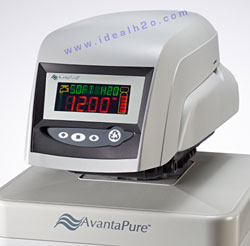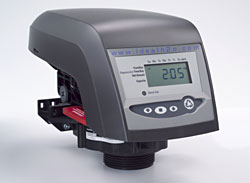Help with My System
Water Softeners
1How do I reset the time of day on my system?
2How do I put my system into the bypass position?
3What should I do with my water softener or filter system when I go on vacation?
When going on vacation and extended trips away from home Ideal Water suggests putting the system into its by-pass position. This will keep the unit from unnecessarily wasting both salt and water when nobody is home. Unplugging the system could also be done but will require resetting the time upon returning home.
4My system is making a lot of noise during the day; does it need to be serviced?
Ideal Water sets all of their systems to regenerate overnight (unless otherwise instructed by the homeowner/resident). The noise that is being referred to is more than likely the system regenerating. Regeneration of a system during the day is typically caused by many small power failures adding up over time. Thus, the clock on the system is running slow, and the regeneration cycle begins on an off hour. This can be verified by checking the time of day on the system. If the time is incorrect wait for the system to finish it regeneration and reset the time of day. If the time is correct, than contact Ideal Water for service.
5What type of salt should I use in my water softener?
Ideal Water recommends the use of water softener salt crystals only in their water softeners.
6How much salt should I keep in my salt tank?
Ideal Water recommends that the salt be kept above the water line in the salt tank as a minimum. Salt can be added all the way to the top of the tank, maximizing the duration of time between needing to fill the tank.
7I completely ran out of salt in my salt tank, did I damage the water softener?
No. In most cases all you need to do is add more salt crystals*, and regenerate the softener manually or wait for its next scheduled regeneration. If the system went for an extended period of time without salt, adding a dose of resin cleaner (Iron Out or Pro-Rust Out) will help clean up the resin and remove any build up within the machine.
*When adding salt to a completely empty tank, it may be necessary to remove some of the water present to avoid displacing the water to the point of overflowing the salt tank.
8When should I add a rust remover or Pro-Rust Out (Iron Out) cleaner to the salt tank?
Pro-Rust Out (Iron Out) should be added whenever salt is added or every three months, whichever is sooner. The cleaner should be mixed into a solution of about 4-5 ounces to one gallon of water. The solution should be poured into the salt tank, over the salt.
Ultraviolet (UV) & Chemical Injection
1How often do I have to change my UV bulb?
All UV bulbs should be changed every twelve (12) months to ensure proper disinfection of the water.
2How often do I have to clean my UV system?
Ideal Water suggests that a new UV system be cleaned twelve (12) months after installation, at the same time as the first bulb change. Depending on the quality of the water and the clarity of the quartz sleeve, a duration of two years may be ok. It would not be our recommendation to exceed two years between cleanings. Ideal Water is available for this service. To avoid damage to the system, we advise that for the first time this service should be conducted by a trained individual. This will allow you to be instructed on the technique and possible pitfalls of your particular system.
3What should I do with my UV system during or after a power outage?
Most all UV systems are used on water supplies that originate from a well. The understanding here is that if there is no power the UV system will not be working, and the well pump will not be able to deliver water from the well. HOWEVER: Water may be stored, under pressure, for use in the well tank. This water, if used during a power outage, will not be treated as it passes through the UV. Using the water at this time may be unsafe. When possible try not to use any water until the power comes back on and you have verified the operation of the UV system.
If the water has been used during the outage, disinfection of the plumbing would be necessary to make certain the water is potable.
If the homeowner has a generator installed to maintain power to the well and other key appliances in the home, it is important to power the UV on a generator circuit too.
4Does my chemical injection system need regular service?
Depending on the brand or type of pump, regular maintenance is required to ensure adequate, continuous operation. Contact us to determine the exact needs of your pump.
Reverse Osmosis (RO)/Whole House Filters
1How often should I change my filters on my RO system?
Different RO systems give different time intervals referring to filter/element changes. The average time for the RO elements is two to three (2-3) years, and for the pre and post filters the length of time ranges from nine to eighteen (9-18) months.
2My RO system does not flow water like it used to, why?
Poor production of an RO system that has been in service for some time is usually due to fouling of the pre-filter, membrane, or both. Replace the pre-filter first, but if that does not correct the problem, replace the membrane.
3When do I change my whole house filter cartridge?
Typically filters should be changed when a noticeable pressure drop has occurred. It is a good idea to inspect the cartridge after the first six months of operation if no pressure drop has been noticed. This inspection verifies that the filter is not damaged and allows you to visually see the amount of sediment that is being collected.
4What micron filter cartridge should I be using?
The average homeowner should use a filter with a micron rating of 20. The use of any filter less than 20 microns as a point-of-use (POU) filter may inhibit the flow of water to the building. If there is a need for a smaller micron filter, Ideal Water suggests using multiple filters in series, stepping down from the larger micron rating to the smaller micron rating. This will extend the life of each cartridge.
5I have to change my filters more frequently than I used to. Why?
There could be many reasons; a low water table, or land development near by. The first thing to do is drain and purge the well tank by a process called blowing down. This will help reduce the amount of sediment in the tank, and may solve the problem.










